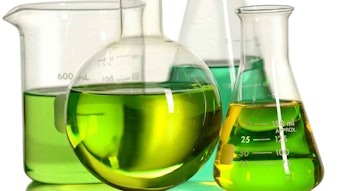Preface: This “Ingredient Profile” column is intended to educate the audience of Cosmetics & Toiletries magazine about the chemistry, manufacture and technology associated with the ingredients employed in cosmetics and personal care products. Although the column is geared primarily toward formulators and product developers, the content will also benefit those in roles such as analytical sciences, process engineering, product stewardship, regulatory compliance, quality assurance, purchasing, marketing and sales.
Each month, “Ingredient Profile” will feature an ingredient according to its International Nomenclature Cosmetic Ingredient (INCI) name. The column will emphasize ingredients that are the products of chemical manufacturing processes to educate readers about the feedstocks and synthesis routes employed to produce cosmetic and personal care ingredients. Key chemical and physical properties of ingredients, reported ingredient functions and product applications also will be presented. Finally, the column will aim to provide readers with concise, well-referenced explanations of the mechanisms of action by which the highlighted ingredients achieve their desired functions.
Chemistry and Manufacture
PEG-150 distearate (INCI: PEG-150 Distearate) (see Figure 1) is defined as the polyethylene glycol (PEG) diester of stearic acid, wherein the PEG has an average degree of polymerization of 150 oxyethylene repeat units1 corresponding to an average molecular weight (MW) of 6,600 g/mol. The overall average MW of PEG-150 distearate is 7,170 g/mol—sufficiently high enough to categorize the ingredient as a low MW polymer. PEG-150 is a telechelic polymer, i.e., it is functionalized with a hydrophobic stearate ester on both the α and ω ends of the hydrophilic PEG chain so that both ends of the polymer exhibit surface and interfacial activity.
PEG diesters typically are produced by one of three routes: 1) ethoxylation of fatty acids, 2) direct esterification of PEG with fatty acids to produce water as a by-product, or 3) transesterification of fatty acid esters with PEG to produce alcohols as byproducts.2, 3 In the case of PEG-150 distearate, only Routes 2 and 3 are desirable since Route 1 leads to mixtures of mono- and difunctional PEG esters and unmodified PEG.
Figure 2 shows the synthesis of PEG-150 distearate via Route 2 in the presence of an acidic esterification catalyst and an antioxidant (to prevent PEG degradation) under heat and vacuum.4 Critical commodity feedstocks for the production of PEG-150 distearate are ethylene oxide, derived from ethylene, which is used to produce the PEG-150; and stearic acid for direct esterification, or methyl stearate for transesterification.
Properties
PEG-150 distearate typically is supplied as solid, white to off-white waxy flakes that melt at approximately 52–57°C. Potential impurities in the raw material can include: unreacted stearic acid or methyl stearate; monofunctional PEG-150 stearate; unreacted PEG-150; (trans)esterification catalyst residues; trace organic peroxides that result from oxidation of PEG; and 1,4-dioxane, a by-product of ethylene oxide poly-merization to produce PEG-150 diol.5 PEG-150 distearate is water-soluble; however, it must be heated above its melting point to achieve effective dissolution and its solubility is tremendously enhanced in the presence of other surfactants.
Technology and Applications
PEG-150 distearate is mainly used as a micellar thickening agent for surfactant-based cleansers, especially shampoos, shower gels and face washes.5 Although the exact mechanism of rheology modification by PEG-150 distearate in surfactant solutions is not fully elucidated, it generally is accepted that PEG-150 distearate would function similarly to other low MW telechelic hydrophobically modified polymers.6–9
Such molecules incorporate into surfactant micelles, where they can:
- increase the hydrodynamic size and viscous drag of micelles in solution by extension of hydrated PEG chains into the aqueous phase;
- increase the micellar radius of curvature to promote wormlike micelle formation—due to incorporation of the bulky C18 stearate hydrophobes into the micellar core and shielding of electrostatic head group repulsions between ionic surfactants by the nonionic PEG chains; and
- physically crosslink micelles via intermicellar bridging.
Individually or in combination, each of these mechanisms typically leads to increases in the bulk viscosity of surfactant solutions. Besides an increase in bulk viscosity, PEG-150 distearate may impart other rheological effects; for example, intermicellar physical crosslinking can dramatically increase the storage modulus, i.e. elasticity, of a micellar surfactant solution.
An important specification for PEG-150 distearate is the saponification value, a measure of the degree of esterification of the PEG ester, which is reported in mg KOH/g PEG ester. For PEG-150 distearate, a higher saponification value generally indicates a higher level of disubstituted PEG chains in the material, which corresponds to higher thickening efficiency.
PEG-150 distearate has an HLB value of about 18, thus the ingredient can also be used as a nonionic emulsifier for o/w systems. In addition, the use of PEG-150 distearate in color cosmetics, hair conditioner and shaving preparations has been reported in the literature.5
Finally, to overcome the need for the hot processing of formulas containing PEG-150 distearate to achieve effective dissolution, as previously described, raw material suppliers also provide the ingredient in concentrated aqueous blends with common anionic, amphoteric, and/or nonionic surfactants such as sodium trideceth sulfate, cocamidopropyl betaine and PEG-80 sorbitan laurate. Such blends simplify formulating by premixing ingredients that are commonly employed together, e.g., the amphoteric and nonionic surfactants used in baby shampoos, and enabling ambient temperature processing.
References
Send e-mail to [email protected].
1. PEG-150 Distearate, Monograph ID 2034, in the International Cosmetic Ingredient Dictionary and Handbook, 13th ed, Washington DC: Personal Care Products Council (2010)
2. LL Walton, Polyoxyethylene fatty acid esters, Amer Perfumer and Cosmet 77 10 41–43 (1962)
3. HA Goldsmith, Polyhydric alcohol esters of fatty acids. Their preparation, properties and uses, Chem Rev 33 257–349 (1943)
4. JP 56050925A, Polyethylene glycol diesters with fatty acids, T Katsumi, Y Masuhiro and I Hiroshi, assigned to Lion Co, Ltd (May 8, 1981)
5. FA Andersen, Final Report on the Safety Assessment of PEG-2, -3, -4, -6, -8, -9, -12, -20, -32, -50, -75, -120, -150 and -175 Distearate, Int J Toxicol 18(1 suppl) 51–59 (1999)
6. U Kortemeier, J Venzmer, A Howe, B Gruening and S Herrwerth, Thickening agents for surfactant systems, SÖFW J 136 3 30–38 (2010)
7. T Yoshida, R Taribagil, MA Hillmyer and TP Lodge, Viscoelastic synergy in aqueous mixtures of wormlike micelles and model amphiphilic triblock copolymers, Macromolecules 40 5 1615–1623 (2007)
8. TP Lodge, R Taribagil, T Yoshida and MA Hillmyer, SANS evidence for the cross-linking of wormlike micelles by a model hydrophobically modified polymer, Macromolecules 40 13 4728–4731 (2007)
9. L Ramos and C Ligoure, Structure of a new type of transient network: Entangled wormlike micelles bridged by telechelic polymers, Macromolecules 40 4 1248–1251 (2007)










